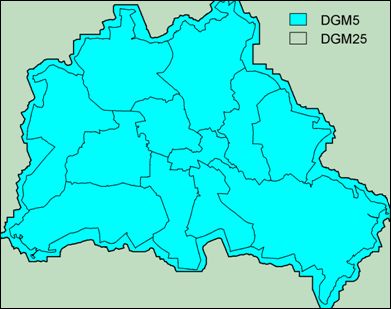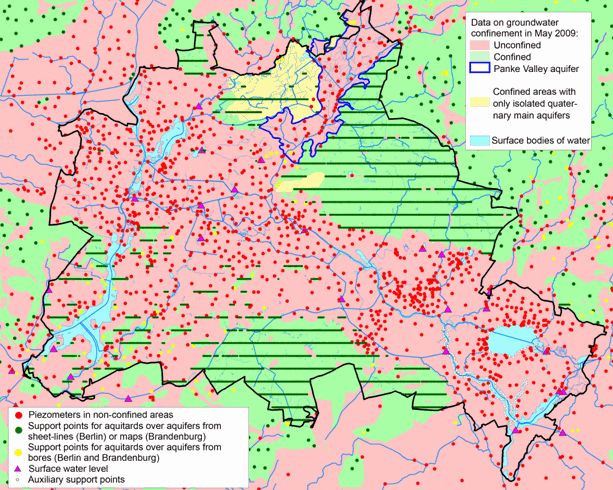The ascertainment of groundwater levels is based on data taken from 1496 groundwater measurement sites (piezometers) of the Berlin State Groundwater Service and the Berlin Water Utility of May 2009. In addition, measurement data from the Brandenburg State Environmental Agency and water-supply companies in the areas surrounding Berlin were integrated into the process.
Areas in Berlin with confined potentiometric surfaces were investigated using the digital information on hydro-geological sections of the Geological Atlas (SenStadt 2002) of Berlin, as well as selected bores from the drilling archives (cf. Fig. 6). At these measurement points, it was not the water levels, but rather the lower surfaces of the aquitards that were ascertained digitally. Drillings and additional depth-related information from the stock of hydro-geological maps were also used for areas in the surrounding countryside in Brandenburg which are within the “Berlin Special Sheet-Lines” area (ZGI 1983).
Moreover, numerous auxiliary support points for water elevations along the surface waters were included in the determination of the regional distribution of the potentiometric surface. These points were used only in areas undisturbed by water-utility activity. In Berlin, such locations are found exclusively in the outlying areas (e.g. along the Dahme or the upper Havel). The reason for the inclusion of these support points is to avoid calculating groundwater levels above the table along these waters. Thus, even such small streams as the Große Kuhlake in the Spandau Forest or the Tegel or Neuenhagen Mill Streams (Erpe) were considered in this context.
The derivation of the two-dimensional information on groundwater confinement here described is based on the one hand on the existing invariant data on the spatial distribution of subsurface aquifers and aquitards, and on the other, on the data, which is variant in time, on the free top surface of the groundwater in areas without impeding surface layers for the near-surface groundwater. Since the level of the unconfined potentiometric surface can vary in Berlin by several decimeters, depending on the time intervals of comparison, it is also possible that there could be an area marked as “unconfined” in May 2006 which could prove to be “confined” in May 2009, and vice-versa.
For this reason, the above-mentioned analysis of the spatial distribution of groundwater confinement had to be checked with the aid of the information on the groundwater levels in May 2009, or repeated. The result is shown in Fig. 6.


